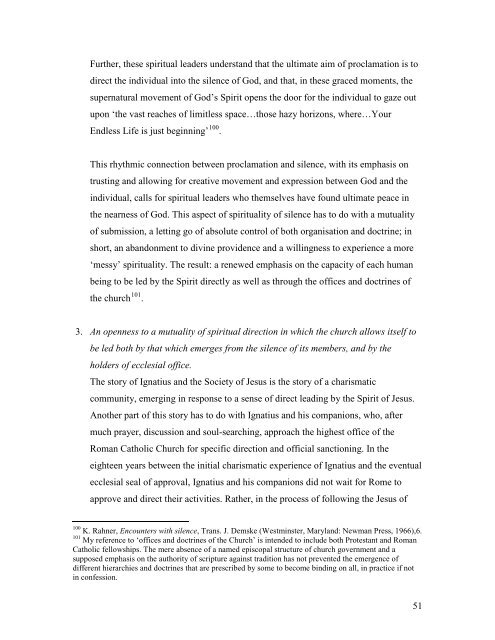Introductory notes for readers of this thesis - Theses - Flinders ...
Introductory notes for readers of this thesis - Theses - Flinders ...
Introductory notes for readers of this thesis - Theses - Flinders ...
Create successful ePaper yourself
Turn your PDF publications into a flip-book with our unique Google optimized e-Paper software.
Further, these spiritual leaders understand that the ultimate aim <strong>of</strong> proclamation is todirect the individual into the silence <strong>of</strong> God, and that, in these graced moments, thesupernatural movement <strong>of</strong> God’s Spirit opens the door <strong>for</strong> the individual to gaze outupon ‘the vast reaches <strong>of</strong> limitless space…those hazy horizons, where…YourEndless Life is just beginning’ 100 .This rhythmic connection between proclamation and silence, with its emphasis ontrusting and allowing <strong>for</strong> creative movement and expression between God and theindividual, calls <strong>for</strong> spiritual leaders who themselves have found ultimate peace inthe nearness <strong>of</strong> God. This aspect <strong>of</strong> spirituality <strong>of</strong> silence has to do with a mutuality<strong>of</strong> submission, a letting go <strong>of</strong> absolute control <strong>of</strong> both organisation and doctrine; inshort, an abandonment to divine providence and a willingness to experience a more‘messy’ spirituality. The result: a renewed emphasis on the capacity <strong>of</strong> each humanbeing to be led by the Spirit directly as well as through the <strong>of</strong>fices and doctrines <strong>of</strong>the church 101 .3. An openness to a mutuality <strong>of</strong> spiritual direction in which the church allows itself tobe led both by that which emerges from the silence <strong>of</strong> its members, and by theholders <strong>of</strong> ecclesial <strong>of</strong>fice.The story <strong>of</strong> Ignatius and the Society <strong>of</strong> Jesus is the story <strong>of</strong> a charismaticcommunity, emerging in response to a sense <strong>of</strong> direct leading by the Spirit <strong>of</strong> Jesus.Another part <strong>of</strong> <strong>this</strong> story has to do with Ignatius and his companions, who, aftermuch prayer, discussion and soul-searching, approach the highest <strong>of</strong>fice <strong>of</strong> theRoman Catholic Church <strong>for</strong> specific direction and <strong>of</strong>ficial sanctioning. In theeighteen years between the initial charismatic experience <strong>of</strong> Ignatius and the eventualecclesial seal <strong>of</strong> approval, Ignatius and his companions did not wait <strong>for</strong> Rome toapprove and direct their activities. Rather, in the process <strong>of</strong> following the Jesus <strong>of</strong>100 K. Rahner, Encounters with silence, Trans. J. Demske (Westminster, Maryland: Newman Press, 1966),6.101 My reference to ‘<strong>of</strong>fices and doctrines <strong>of</strong> the Church’ is intended to include both Protestant and RomanCatholic fellowships. The mere absence <strong>of</strong> a named episcopal structure <strong>of</strong> church government and asupposed emphasis on the authority <strong>of</strong> scripture against tradition has not prevented the emergence <strong>of</strong>different hierarchies and doctrines that are prescribed by some to become binding on all, in practice if notin confession.51















